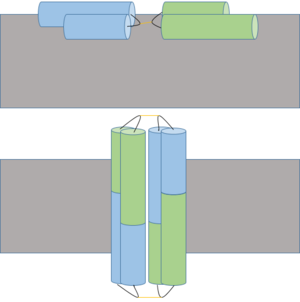Sandbox Reserved 996
From Proteopedia
(Difference between revisions)
| Line 23: | Line 23: | ||
Ectatomin has several proposed mechanisms of action. The primary proposed mechanism involves the formation of a nonselective cation channel. In this mechanism, the α and β subunits open up, exposing the internal hydrophobic residues.<ref name="refone" /> The protein flattens while remaining attached at the hairpin hinge region. The now exposed hydrophobic residues nonselectively insert into plasma membranes.<ref name="refone" /> The inserted protein dimerizes, eventually forming a nonselective cation channel.<ref name="refthree" /> | Ectatomin has several proposed mechanisms of action. The primary proposed mechanism involves the formation of a nonselective cation channel. In this mechanism, the α and β subunits open up, exposing the internal hydrophobic residues.<ref name="refone" /> The protein flattens while remaining attached at the hairpin hinge region. The now exposed hydrophobic residues nonselectively insert into plasma membranes.<ref name="refone" /> The inserted protein dimerizes, eventually forming a nonselective cation channel.<ref name="refthree" /> | ||
| - | For the second and third proposed mechanisms of action, Ectatomin has also been shown to inhibit kinases, specifically protein tyrosine kinase and protein kinase C, and Ca<sup>2+</sup> channels. Kinase inhibition would potentially allow Ectatomin to interfere with various components of signal transduction.<ref name="refthree" /> Calcium channel inhibition would potentially allow Ectatomin to affect physiological processes such as contraction, neurotransmitter release and neuronal activity regulation.<ref name="reffour" /> | + | For the second and third proposed mechanisms of action, Ectatomin has also been shown to inhibit kinases, specifically protein tyrosine kinase and protein kinase C, and natural Ca<sup>2+</sup> channels. Kinase inhibition would potentially allow Ectatomin to interfere with various components of [https://en.wikipedia.org/wiki/Signal_transduction signal transduction].<ref name="refthree" /> Calcium channel inhibition would potentially allow Ectatomin to affect physiological processes such as contraction, neurotransmitter release and neuronal activity regulation.<ref name="reffour" /> |
== Toxicology == | == Toxicology == | ||
| - | With an LD<sub>50</sub> of 6.8 μg kg<sup>-1</sup>, Ectatomin is one of the deadliest proteins known to man, alongside [https://en.wikipedia.org/wiki/Tetanospasmin Tetanospasmin] and the [https://en.wikipedia.org/wiki/Botulinum_toxin Botulinum toxin].<ref name=" | + | With an LD<sub>50</sub> of 6.8 μg kg<sup>-1</sup>, Ectatomin is one of the deadliest proteins known to man, alongside [https://en.wikipedia.org/wiki/Tetanospasmin Tetanospasmin] and the [https://en.wikipedia.org/wiki/Botulinum_toxin Botulinum toxin].<ref name="refthree" /> Ectatomin attacks and forms pores in the plasma membrane, allowing cations to freely move in and out of the cell.<ref name="refone" /> The primary cations which flow through the pore are Ca<sup>2+</sup> and K<sup>+</sup>. Physiologically, the primary targets of Ectatomin are muscle cells, particularly the heart, and neurons. As the cation concentration equilibrates between the two sides of the cell membrane, the affected cells lose their ability to maintain and form a [https://en.wikipedia.org/wiki/Membrane_potential membrane potential] and concentration gradient.<ref name="reftwo" /> Without the ability to form a calcium or potassium gradient, muscle cells are not able to contract and the target is rendered paralyzed. This is particularly dangerous when the heart is affected as it halts the circulatory system.<ref name="reftwo" /> When neurons are affected, the inability to maintain and form a membrane potential eliminates the ability of the neuron to receive and transmit information.<ref name="refthree" /> |
| - | + | ||
| - | + | ||
| - | <ref name=" | + | |
| - | + | ||
| - | <ref name=" | + | |
| - | + | ||
| - | + | ||
| - | + | ||
| - | + | ||
== References == | == References == | ||
<references/> | <references/> | ||
Revision as of 01:05, 11 March 2015
Ectatomin (1eci)
| |||||||||||

